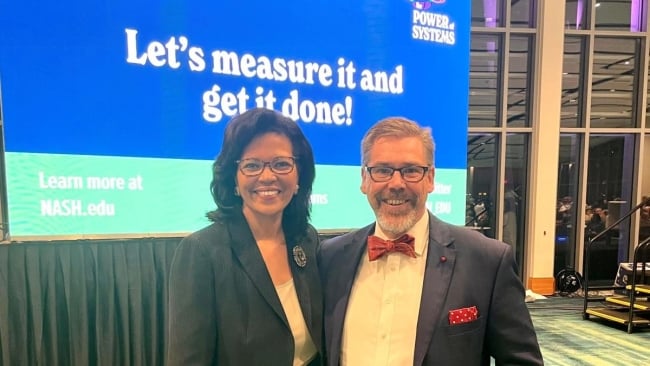You have /5 articles left.
Sign up for a free account or log in.

Kim Hunter Reed, Louisiana’s higher education commissioner and keynote speaker at NASH's “superconvening,” and Tristan Denley, chair of NASH’s “College Is Worth It” task force
David Belsky
NATIONAL HARBOR, Md.—A coalition of dozens of public university systems across the country is launching a campaign aimed at improving public perception of the value of higher education—in part by measuring those institutions’ current contributions and committing to improve their performance.
The National Association of System Heads, which represents the leaders of 65 university systems, unveiled the “College Is Worth It” campaign Wednesday to a room of university system leaders and other higher education luminaries at NASH’s “superconvening” just outside of Washington, D.C. The campaign aims to push back on years of declining public confidence in the value of higher education, and their negative impact on enrollment, by setting concrete goals for institutions to increase credential attainment, improve social mobility, and reduce student debt.
As part of the campaign, NASH developed a unique data set to gauge its member institutions’ collective impact on improving the value and equity of higher education—and how much work still needs to be done.
“We’re battling a crisis of confidence in higher ed,” David Belsky, a spokesperson for NASH, wrote in an email to Inside Higher Ed. “We know the value of a degree—graduates earn more, live longer, vote often, and are better prepared for the jobs we need. So we’re launching this campaign, with the data to back it up, to improve public perception.”
The initiative seems to be a recognition from higher education leaders that the belief in a college degree as a stepping-stone to social mobility, once nearly universal, is fading.
The initiative comes on the heels of NASH’s “Power of Systems” campaign, launched at last year’s convention, which focused on similar issues. But the scope of “College Is Worth It” goes beyond its predecessor’s: it is both a public relations campaign and a material effort to increase the economic return on investment in a college degree.
While light on specific action plans, the campaign’s goals are ambitious. Currently, about half of all students at NASH institutions who come from families in the bottom 40 percent of income earners end up in the top 40 percent, according to data provided by NASH. Through the College Is Worth It campaign, NASH hopes to increase that rate to 65 percent by 2040.
To put it in the organization’s terms, the institutions want to move 1.5 million people “from poverty to prosperity” and demonstrate that higher education is the driving force in that movement.
“The impact of higher education is incredibly powerful, but that’s not the narrative in the discourse today,” said Jason Lane, a senior fellow at NASH and dean of Miami University of Ohio’s College of Education, Health and Society. “We’ll not only be promoting the idea that college is, in fact, worth it. We’ll be collecting data to prove that.”
Some experts and system leaders at the convention remained bullish on higher education’s worth. At Wednesday’s event, Jay Perman, chancellor of the University System of Maryland, stressed the “intrinsic value” of higher education and emphasized the importance of critical thinking and communication skills, which, he said, were part of a college degree’s inherent worth.
But in launching the College Is Worth It initiative, NASH leaders acknowledged that the higher education sector has struggled to demonstrate its broad financial benefits—and that paeans to higher education’s societal and individual contributions may not be a sufficient defense in the face of mounting student debt and the diminishing role of degrees in the job market.
“There is a lot more to the value of higher education than salary. But also … salary [matters],” Tristan Denley, deputy commissioner for academic affairs and innovation at the Louisiana Board of Regents, told the audience Wednesday. “How can we enable students not only to shake their presidents’ hands at graduation but to shake their employers’ hands as well?”
‘What Gets Measured Gets Done’
A large component of the College Is Worth It campaign will be collecting data on the investment return for college degrees. By putting a metric around social mobility and its connection to college degrees and credentials, Denley said, NASH would be able to make a more convincing case for higher education’s value—to policy makers, students and parents alike.
“We live in an age of evidence,” Denley said. “What gets measured gets done.”
Leaders also said NASH would focus on reducing the debt held by its member systems’ collective five million–plus students by $7 billion by 2030. The average debt per student at NASH institutions is currently just under $20,000, and the systems aim to reduce that by 25 percent by 2030, with a focus on cutting in half the gap in loan repayment rates for students who receive Pell Grants for needy students and those who do not.
“The story of higher ed in the past few decades is the movement of debt from states to families,” Denley said. “The reality is that costs will increase, and as they do, we need to find ways to be more efficient and effective and not just pass that cost on to the student.”
NASH also highlighted failures to address persistent equity gaps in its own efforts. The organization’s member institutions awarded over 900,000 degrees and awards in 2021—up from 664,000 in 2009, or about a 35 percent increase. And yet that growth was not at all evenly distributed across the award types: bachelor’s degree programs grew by 30 percent, while associate degrees and other credentials barely increased at all. Moreover, despite the general rise in degree completion among its member systems, the completion gap between white students and students of color stayed at 10 percent.
“That gap did not close one iota,” Denley said.
Through the College Is Worth It initiative, NASH wants its member systems to increase their credential production by another 35 percent by 2030, but in such a way that the equity gap is closed by 50 percent over the same period.
The campaign isn’t purely focused on NASH institutions, either. Lane told the audience that the organization’s goal applied to all of higher education. But aside from a $55,000 initial investment from NASH, the organization was relying on its members to support the effort.
“There’s some checkbooks and pens in the back of the room, I think,” Lane quipped to the system leaders.
Nancy Zimpher, director of NASH’s Power of Systems campaign and the former chancellor of the State University of New York System, is confident in public systems’ power to reverse the larger narrative around higher education.
“Graduates are three and a half times more likely to significantly improve their income than those who don’t attend college. By moving beyond competition and toward collaboration, systems will ensure that the value proposition is even greater,” she wrote in a statement. “College is worth it, and we’re going to prove it.”





